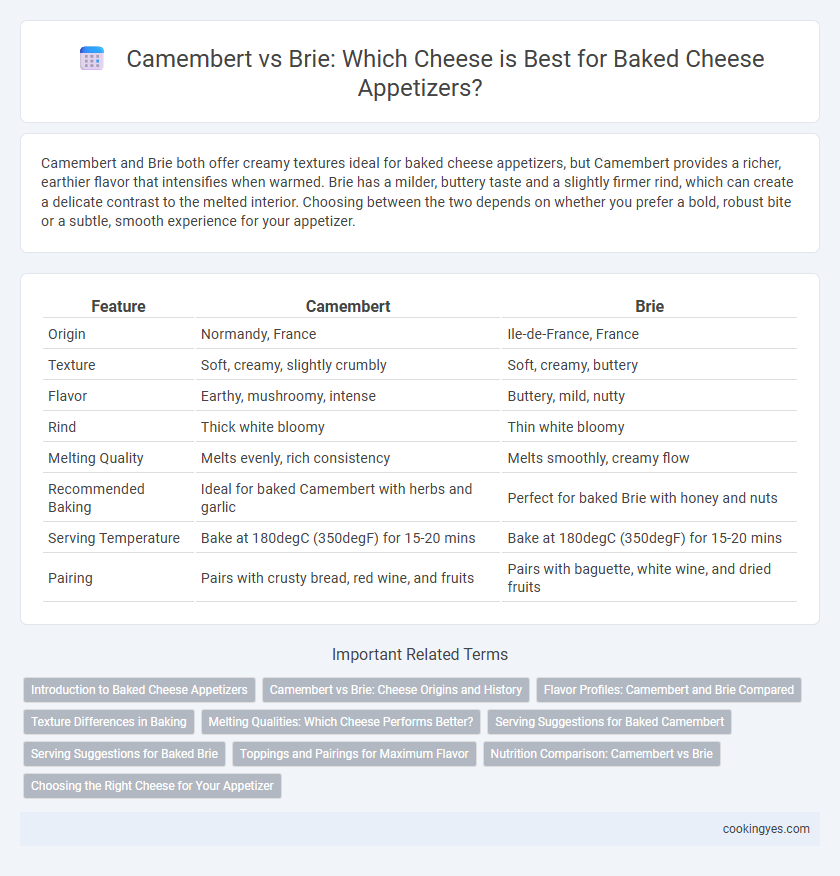Camembert and Brie both offer creamy textures ideal for baked cheese appetizers, but Camembert provides a richer, earthier flavor that intensifies when warmed. Brie has a milder, buttery taste and a slightly firmer rind, which can create a delicate contrast to the melted interior. Choosing between the two depends on whether you prefer a bold, robust bite or a subtle, smooth experience for your appetizer.
Table of Comparison
| Feature | Camembert | Brie |
|---|---|---|
| Origin | Normandy, France | Ile-de-France, France |
| Texture | Soft, creamy, slightly crumbly | Soft, creamy, buttery |
| Flavor | Earthy, mushroomy, intense | Buttery, mild, nutty |
| Rind | Thick white bloomy | Thin white bloomy |
| Melting Quality | Melts evenly, rich consistency | Melts smoothly, creamy flow |
| Recommended Baking | Ideal for baked Camembert with herbs and garlic | Perfect for baked Brie with honey and nuts |
| Serving Temperature | Bake at 180degC (350degF) for 15-20 mins | Bake at 180degC (350degF) for 15-20 mins |
| Pairing | Pairs with crusty bread, red wine, and fruits | Pairs with baguette, white wine, and dried fruits |
Introduction to Baked Cheese Appetizers
Camembert and Brie are top choices for baked cheese appetizers due to their creamy textures and rich flavors. Camembert offers a stronger, earthier taste with a smooth, melting interior ideal for baking, while Brie provides a milder, buttery flavor with a soft rind that crisps beautifully when heated. Both cheeses pair well with fruits, nuts, and crusty bread, making them versatile options for elegant and indulgent baked cheese dishes.
Camembert vs Brie: Cheese Origins and History
Camembert originated in Normandy, France in the late 18th century, known for its creamy texture and earthy flavor, making it ideal for baked cheese appetizers. Brie, with roots dating back to the Brie region near Paris since the 8th century, offers a milder, buttery taste that melts beautifully when baked. The historical distinctions between Camembert and Brie influence their distinct textures and flavors, defining their unique culinary uses in warm dishes.
Flavor Profiles: Camembert and Brie Compared
Camembert offers a stronger, earthier flavor with mushroom and grassy notes, creating a robust taste ideal for baked cheese appetizers seeking depth. Brie provides a milder, buttery, and slightly nutty profile, delivering a creamy texture that melts smoothly in warm dishes. Both cheeses have edible white rinds that develop rich umami flavors when baked, but Camembert's intense aroma contrasts with Brie's subtle sweetness, influencing the overall savory experience.
Texture Differences in Baking
Camembert softens into a creamy, luscious texture when baked, offering a smooth, almost buttery consistency ideal for dipping. Brie maintains a slightly firmer structure with a rich, gooey center, providing a balance between softness and slight bite that holds up well in baked appetizers. These texture differences influence how each cheese interacts with toppings and accompaniments, making Camembert more suited for melt-focused dishes and Brie better for layered flavors.
Melting Qualities: Which Cheese Performs Better?
Camembert offers a creamier texture and melts more uniformly compared to Brie, making it ideal for baked cheese appetizers that require a smooth, gooey consistency. Brie, while also melting well, tends to hold its shape slightly more due to its firmer curd structure, resulting in a less runny finish. For recipes prioritizing a rich, velvety melt, Camembert is the superior choice over Brie.
Serving Suggestions for Baked Camembert
Baked Camembert pairs excellently with crusty baguette slices, fresh apple wedges, and a drizzle of honey to enhance its creamy, earthy flavor. Serve warm with roasted garlic and fresh herbs like rosemary or thyme for a rich, aromatic appetizer. Offering dried fruits and nuts alongside adds a delightful contrast to the smooth, melted cheese texture.
Serving Suggestions for Baked Brie
Baked Brie pairs perfectly with sweet accompaniments like honey, figs, or cranberry sauce to balance its creamy, mild flavor. Serve it warm with crusty baguette slices or buttery puff pastry for an elegant appetizer that melts effortlessly. Garnishing with fresh herbs such as rosemary or thyme elevates the presentation and adds a subtle aromatic note.
Toppings and Pairings for Maximum Flavor
Camembert's rich, earthy flavor pairs exceptionally well with sweet toppings like honey, fig jam, or caramelized onions, enhancing its creamy texture in baked cheese appetizers. Brie complements savory additions such as garlic, herbs, thyme, and walnuts, bringing out its buttery notes and smooth rind. Both cheeses benefit from pairing with crusty baguettes or crisp apples to balance richness and maximize flavor complexity.
Nutrition Comparison: Camembert vs Brie
Camembert and Brie are both rich in protein and calcium, essential for bone health and muscle repair. Camembert typically contains slightly higher fat content, around 24 grams per 100 grams, compared to Brie's approximately 21 grams, affecting calorie intake for baked cheese appetizers. Both cheeses offer similar amounts of vitamin B12, promoting nerve function and energy metabolism in savory dishes.
Choosing the Right Cheese for Your Appetizer
Camembert offers a rich, creamy texture with a slightly earthy flavor, ideal for baked cheese appetizers that require a robust taste. Brie provides a milder, buttery profile with a smooth consistency, making it perfect for those who prefer a delicate cheese experience. Selecting Camembert or Brie depends on the desired flavor intensity and the pairing ingredients in your baked appetizer.
Camembert vs Brie for baked cheese appetizers Infographic

 cookingyes.com
cookingyes.com